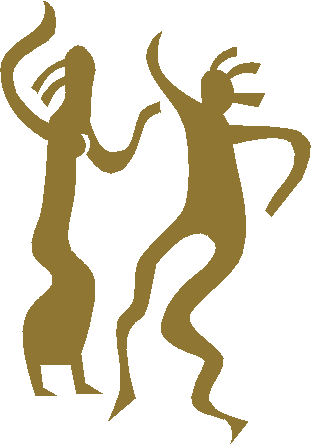MODERN
DANCE TECHNIQUE  Prior to the end of
the sixteenth century, little was known about the specific technique used by the
dancing masters of the time, nor as to the ground rules governing steps and rhythm
patterns of the various dances. Prior to the end of
the sixteenth century, little was known about the specific technique used by the
dancing masters of the time, nor as to the ground rules governing steps and rhythm
patterns of the various dances.
The first authoritative knowledge of the earliest
social dances came from a priest, Jehan Tabourot, who published the Orchesographie in 1588
under the pen name of Thoinot-Arbeau.
Arbeau lived at a transition period when the
rather solemn base danse was gradually giving way to the much livelier branle. He
specifically described the particular branle originating from several French
provinces such as Poitou and Provence, as well as other dances as the pavane and the
galliarde. Shakespeare referred to the last dance as the cinq pace because it was composed
of five steps.
At that time, Arbeau also wrote that a
technique was slowly formed by the dancing masters of the period. It was not however until
the latter part of the seventeenth century that hard and fast rules were laid down.
The French king Louis XIV had founded his Academie
Royale de Musique et de Danse, and its members systematically formulated the ‘five
positions’ of the feet.
Victor Silvester described these: “The ballets
presented in the days of Louis XIV of France consisted of a series of entrees such as the
Minuet and other dances of the period. These dances were therefore spectacular as
well as personal and, being spectacular, they had to be based on a technique which was to
some extent artificial. The legs, for instance, had to be turned out, so as to provide a
more graceful line, and many purely decorative steps such as entrechats and
cabrioles were executed.
“The first definite cleavage between the ballet
and the ballroom came when professional dancers appeared in the ballets, and the ballets
left the Court and went to the stage. But the influence of the ballet technique lingered
for over two centuries and at the close of the Victorian era, the dancing masters still
based their tuition on the ‘turned out’ five positions of the
stage.”
The
MODERN TECHNIQUE
The first beginnings of modern dancing came in 1812,
during which time the modern hold was first used for the Waltz. In a very conservative
Victorian society, this elicited tremendous opposition, for the modern hold called
for the man to wrap his right arm around his partner’s back, so that their bodies
almost touched each other.
The most prominent members of English society created
a howl, and every ballroom became a scene of feud and contention. Such luminaries as Lord
Byron and Sir H. Engelfield provided additional fire against the new
technique.
The protest however lasted but a brief while,
and society started to accept the new dance when the Emperor Alexander of Russia was
observed waltzing in the new style.
By the 1840s, the decorative steps were also dropped
from the new dances that appeared then such as the Polka, the Mazurka, and the
Schottische.
At the end of the century, new developments and
techniques were introduced, particularly coming from more liberal dances in New York --
the Two-Step, the Barn Dance, a new way of dancing to waltz music known as the Boston, and
the Rag -- all of which appealed to the younger generation of the time.
Soon enough, the younger dancers rebelled against the
artificial technique of the old-time teachers. Encouraged by the First World War, when old
institutions were defied, the younger dancers, not the teachers, introduced a free and
easy go-as-you-please style based on the natural movements used in walking.
The introduction of the Foxtrot on stage in 1914
further fanned the rebellion and finally extinguished any lasting vestiges of the old
technique.
A few years later, the Informal Conference of
Teachers in 1920 attempted to standardize the basic steps of the Foxtrot and One-Step. The
Conference eventually lead to the rise of a new hierarchy of ballroom teachers, who
formally recognized the break from the old tradition, and moved for the
codification of a modern ballroom technique based on natural movement, with the feet in
alignment.
The codified technique has since been so
highly developed into the ‘English style’, and together with the ‘American
style’, has influenced modern ballroom dancing and competitions throughout the world.

|
